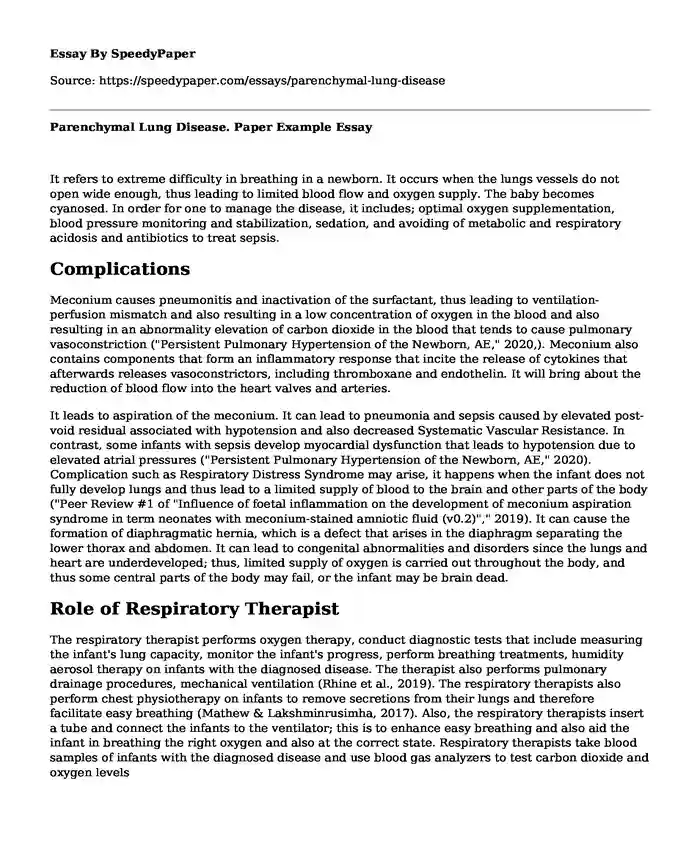It refers to extreme difficulty in breathing in a newborn. It occurs when the lungs vessels do not open wide enough, thus leading to limited blood flow and oxygen supply. The baby becomes cyanosed. In order for one to manage the disease, it includes; optimal oxygen supplementation, blood pressure monitoring and stabilization, sedation, and avoiding of metabolic and respiratory acidosis and antibiotics to treat sepsis.
Complications
Meconium causes pneumonitis and inactivation of the surfactant, thus leading to ventilation-perfusion mismatch and also resulting in a low concentration of oxygen in the blood and also resulting in an abnormality elevation of carbon dioxide in the blood that tends to cause pulmonary vasoconstriction ("Persistent Pulmonary Hypertension of the Newborn, AE," 2020,). Meconium also contains components that form an inflammatory response that incite the release of cytokines that afterwards releases vasoconstrictors, including thromboxane and endothelin. It will bring about the reduction of blood flow into the heart valves and arteries.
It leads to aspiration of the meconium. It can lead to pneumonia and sepsis caused by elevated post-void residual associated with hypotension and also decreased Systematic Vascular Resistance. In contrast, some infants with sepsis develop myocardial dysfunction that leads to hypotension due to elevated atrial pressures ("Persistent Pulmonary Hypertension of the Newborn, AE," 2020). Complication such as Respiratory Distress Syndrome may arise, it happens when the infant does not fully develop lungs and thus lead to a limited supply of blood to the brain and other parts of the body ("Peer Review #1 of "Influence of foetal inflammation on the development of meconium aspiration syndrome in term neonates with meconium-stained amniotic fluid (v0.2)"," 2019). It can cause the formation of diaphragmatic hernia, which is a defect that arises in the diaphragm separating the lower thorax and abdomen. It can lead to congenital abnormalities and disorders since the lungs and heart are underdeveloped; thus, limited supply of oxygen is carried out throughout the body, and thus some central parts of the body may fail, or the infant may be brain dead.
Role of Respiratory Therapist
The respiratory therapist performs oxygen therapy, conduct diagnostic tests that include measuring the infant's lung capacity, monitor the infant's progress, perform breathing treatments, humidity aerosol therapy on infants with the diagnosed disease. The therapist also performs pulmonary drainage procedures, mechanical ventilation (Rhine et al., 2019). The respiratory therapists also perform chest physiotherapy on infants to remove secretions from their lungs and therefore facilitate easy breathing (Mathew & Lakshminrusimha, 2017). Also, the respiratory therapists insert a tube and connect the infants to the ventilator; this is to enhance easy breathing and also aid the infant in breathing the right oxygen and also at the correct state. Respiratory therapists take blood samples of infants with the diagnosed disease and use blood gas analyzers to test carbon dioxide and oxygen levels
Nurses role
The nurse should enhance the infant's ability to breathe by ensuring a warm environment, delaying baths, preventing agitation, and also provision of glucose. It will aid in decreasing oxygen requirements and keep the infant calm (Mathew & Lakshminrusimha, 2017). The nurse should also ensure that the airway is secured and continually monitor the oxygen saturation, and vital signs, and also ensure that the infant is responding well to the drugs (Rhine et al., 2019). The nurse should conduct an assessment to ensure that there are no adverse drug reactions or paralysis. The nurse should conduct eye care in order to prevent corneal abrasions, suctioning in order to clear secretions, and position changing to improve skincare and bedsores (Mathew & Lakshminrusimha, 2017). The nurse should also accurately document the infant's health status, oxygen saturation changes, and blood gas results and also work in partnership with other health teams that include doctors, and respiratory therapists to ensure that the baby is managed well and effectively and also reduce errors that include risks of pulmonary leaks and early detection and treatment of new diseases that tend to endanger the infant's life.
References
Mathew, B., & Lakshminrusimha, S. (2017). Persistent Pulmonary Hypertension in the Newborn. Children, 4(8), 63.
Peer Review #1 of "Influence of foetal inflammation on the development of meconium aspiration syndrome in term neonates with meconium-stained amniotic fluid (v0.2)". (2019).
Persistent Pulmonary Hypertension of the Newborn, AE. (2020). Definitions.
Rhine, W. D., Suzuki, S., Potenziano, J. L., Escalante, S., & Togari, H. (2019). An Analysis of Time to Improvement in Oxygenation in Japanese Preterm and Late Preterm or Term Neonates With Hypoxic Respiratory Failure and Pulmonary Hypertension. Clinical Therapeutics, 41(5), 910-919.
Cite this page
Parenchymal Lung Disease. Paper Example. (2023, Aug 20). Retrieved from https://speedypaper.net/essays/parenchymal-lung-disease
Request Removal
If you are the original author of this essay and no longer wish to have it published on the SpeedyPaper website, please click below to request its removal:
- Free Essay on Euthanasia: Situational Analysis of an Ethical Dilemma
- Essay Sample: Social Media Marketing Case Study
- Essay Sample on Career Interview: Daniel Fernandez
- Addressing Healthcare Challenges - Free Essay Sample
- Free Essay Example - Metacognitive Work
- Essay Sample on Maternity and Paternity Leave
- Paper Example: Brain Development - Middle Childhood and Adolescent Development
Popular categories





